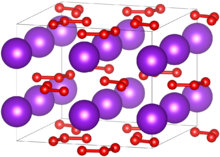Chemistry:Potassium ozonide

| |
| Identifiers | |
|---|---|
3D model (JSmol)
|
|
PubChem CID
|
|
| |
| |
| Properties | |
| KO3 | |
| Molar mass | 87.10 g/mol |
| Appearance | Red crystalline solid |
| Density | 1.990 g/cm3[1] |
| Melting point | 25 °C (77 °F; 298 K) (decomposes)[3] |
| Reacts | |
| Solubility | Soluble in liquid anhydrous ammonia[2] |
Refractive index (nD)
|
1.39 |
| Structure[4][5] | |
| I4/mcm | |
a = 8.597 Å, c = 7.080 Å
| |
Formula units (Z)
|
8 |
| Related compounds | |
Other anions
|
Potassium fluoride Potassium chloride Potassium bromide Potassium iodide |
Other cations
|
Sodium ozonide Rubidium ozonide Caesium ozonide |
| Potassium oxide Potassium peroxide Potassium superoxide | |
Except where otherwise noted, data are given for materials in their standard state (at 25 °C [77 °F], 100 kPa). | |
| Infobox references | |
Potassium ozonide is an oxygen rich compound of potassium. It is an ozonide, meaning it contains the ozonide anion (O3−). In polarized light, it shows pleochroism.[1] Hybrid functional calculations have predicted the compound is an insulator with a band gap of 3.0 eV, and has magnetic behavior which departs from the Curie–Weiss law.[6]
The compound can be created by reacting ozone with potassium hydroxide, but the yield is quite low, only 5-10%.[7]
- [math]\ce{ 6KOH + 4O3 -> 4KO3 + 2KOH (H2O) + O2 }[/math]
The compound is metastable, and will decompose to potassium superoxide and oxygen, especially if there is any water in the atmosphere. Long-term storage in very dry atmosphere is possible below around 0 °C.[3]
- [math]\ce{ KO3 -> KO2 + 1/2 O2 }[/math]
This compound reacts with water to form potassium hydroxide and potassium superoxide.[4]
References
- ↑ 1.0 1.1 Sokol, V. I.; Tokareva, S. A.; Sokovnin, E. I. (1963). "Determination of density and index of refraction of ozonides of sodium and potassium". Bulletin of the Academy of Sciences, USSR Division of Chemical Science (Springer Science and Business Media LLC) 12 (12): 2051–2052. doi:10.1007/bf00844013. ISSN 0568-5230.
- ↑ Makarov, S. Z.; Sokovnin, E. I. (1961). "О РАСТВОРИМОСТИ ОЗОНИДА КАЛИЯ В СЖИЖЕННОМ АММИАКЕ" (in ru). Proceedings of the USSR Academy of Sciences 137 (3): 612–613. http://mi.mathnet.ru/dan24783. English translation
- ↑ 3.0 3.1 Petrocelli, W.; Capotosto, A. (1971). "Concerning the thermal stability of potassium ozonide". Inorganica Chimica Acta (Elsevier BV) 5: 453–456. doi:10.1016/s0020-1693(00)95963-2. ISSN 0020-1693.
- ↑ 4.0 4.1 Azaroff, L. V.; Corvin, I. (1963-01-01). "Crystal Structure of Potassium Ozonide". Proceedings of the National Academy of Sciences 49 (1): 1–5. doi:10.1073/pnas.49.1.1. ISSN 0027-8424. PMID 16591034. Bibcode: 1963PNAS...49....1A.
- ↑ Kellersohn, Thomas; Korber, Nikolaus; Jansen, Martin (1993). "Experimental electron density of the ozonide ion (O3−) in potassium ozonide, KO3". Journal of the American Chemical Society (American Chemical Society (ACS)) 115 (24): 11254–11258. doi:10.1021/ja00077a026. ISSN 0002-7863.
- ↑ Llunell, Miquel; Alemany, Pere; Moreira, Ibério de P. R. (2009-05-22). "Electronic Structure and Magnetic Properties of Potassium Ozonide KO3". Inorganic Chemistry (American Chemical Society (ACS)) 48 (13): 5938–5945. doi:10.1021/ic900287h. ISSN 0020-1669. PMID 19463009.
- ↑ A. W. Petrocelli; A. Capotosto (November 1964). The Synthesis and Utilization of Low Molecular Weight Ozonides for Air Revitalization Purposes (Report). Washignton DC: National Aeronautics and Space Administration. https://ntrs.nasa.gov/citations/19660017587.
 |

